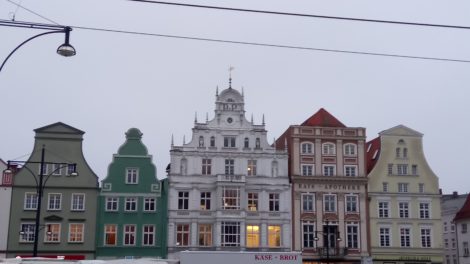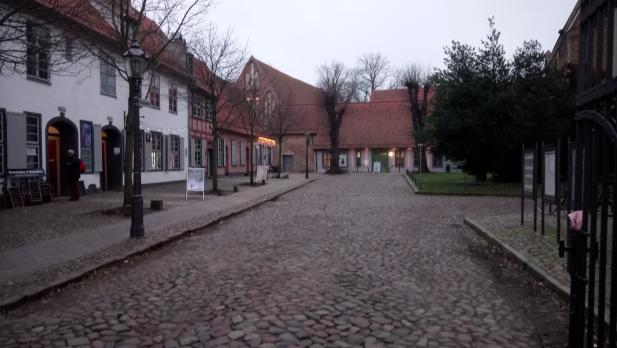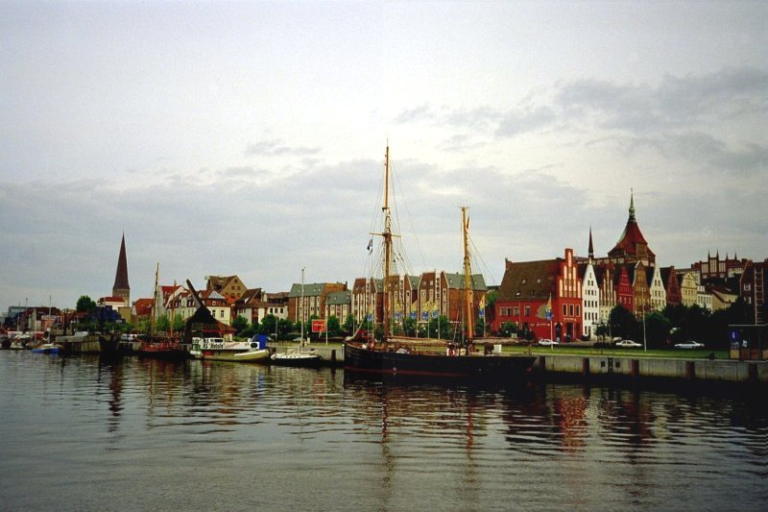To understand Rostock slightly better, we summarised some historical highlights for you.
History
Already around 600 Slavs have a settlement right at the place where we are living today. In their language they called the diffluence of the Warnow rastokŭ and thereby giving the city it’s name. In 1165 he name Rozstoc was first mentioned. First craftsmen and merchants settled near the Warnow during the 12th century. As a result the Nikolaikirche, the Jakobikirche (which was completely destroyed during the 2nd World War) and in 1232 the tall Marienkirche in the city centre developed. At that time Rostock’s town hall emerged as well. From that point on the city grew rapidly. During the 13th century the right side of the Warnow was already incorporated.
Rostock has increasingly gained in importance in the Hanseatic League. The association of low German merchants existing between the middle of the 12th and the middle of the 17th century, had the objective to ensure the safety of crossing and the representation of common economic interests especially overseas. The Hanseatic League was an important factor not only on an economic level, but also in politics and culture. Down to the present day the cityscape is characterised by the success of the former merchants. Many of the buildings in the Kröpeliner Straße once have been residential and commercial buildings of successfull merchants.
The foundation of the university – the oldest university of Northern Europe – was a visible sign of Rostock’s significance.
In the 16 th century the reformation did not leave Rostock untouched. Only the university as well as the monasteries Zum Heiligen Kreuz, St. Johanni and the charterhouse in Marienehe resisted and remained faithful to the old doctrine. In June 1549 Johann Albrecht enforced the Lutheran faith for all estates of the country at the parliament at Sternberg and shut down almost every Mecklenburg monastery.
Approximately 14.000 inhabitants, living in about 800 gable houses and 250 to 300 brewhouses, became an economic highlight by the end of the 16th century and an expression of rising affluence. In the focus and the main source of income were the maritime trade and the brewing industry.
The end of the Hanseatic League was marked by the Thirty Years‘ War (1618-1648). With Denmark’s entry into the war it came to the North of Germany. Rostock has been converted and occupied with 1000 soldiers. The siege ended in 1631 followed by the “Schwedenzeit”. Mecklenburg villages have been plundered, in contrast, however, the city walls provided protection for many refugees. Maritime trade decreased dramatically and duties imposed impeded the trade even more. City fires destroyed large parts of the city. From 1806 to 1808 and from 1810 to 1813 Rostock was occupied by French troops, which again made an economic rise impossible.
The situation changed during the 19th century. Maritime trade grew constantly and raised the biggest merchant fleet in the Baltic Sea region. The connection to the German railway network came in 1850. Thus followed the freedom of trade and a comprehensive industrialisation in the city. Among other things, this has led to the first large industrial concern of Mecklenburg, the stock corporation „Neptun“ Schiffswerft und Maschinenfabrik in Rostock today known as Neptun-Werft.
The First and Second World War also left traces in Rostock. The largest ones include economic crises, mass unemployment, inflation and the fragmentation of political parties. The city also became the target of an air raid by the Royal Air Force on the night of April 23/24 1942. At that time Rostock was the most destroyed city in the whole republic. The historic city centre was particularly affected. Air raids in May and October of 1942 followed as well as in April 1943 and April 1944. By the end of the war almost 25 per cent of the residential buildings were completely destroyed, further 6.735 damaged. On the 1st of May Rostock has been occupied by the Red Army virtually without a struggle.
The reconstruction started in 1949 between the Marienkirche and the Grubenstraße, though the historical streets have only been partly reconstructed. A prestige project of the reconstruction should have been introduced by the building of the new city quarter Reutershagen in the style of the socialist classicism. On the other, there is the formation of city quarters in the style of industrial concrete slab such as Dierkow, Evershagen, Lütten Klein, Schmarl and Toitenwinkel. As a result 54.000 new apartments developed.
After the German reunification in 1990 Rostock had to struggle with economic challenges and a decline in population. The peak was reached with the xenophobic excesses of Lichtenhagen in August 1992. Back then several hundred partly extremist rioters and up to 300 applauding spectators participated. The incident is even today still considered one of the most massive racially motivated aussaults in post-war history. Many people in Rostock face the incident by establishing numerous campaigns and initiatives in the former eastern part and throughout Germany to encourage education in fields such as democratic culture, social interaction and cosmopolitanism.
Since 1990 Rostock bears the title Hanseatic City.
Facts on Rostock
The Hanseatic League
Rostock is also called a hanseatic town. The Hanseatic League was a commercial and defensive confederation of merchant guilds and their towns, starting in the middle of the twelves century until the middle of the 17th century. A safe crossing and the representation of common economic interests abroad was the Hanse’s goal. Up to 300 towns and cities have been members of the Hanseatic League in northern Europe at the same time. The Hanse served economic, political and cultural interests.

Some hanseatic cities are among others are Hamburg, Bremen, Anklam, Wismar, Stralsund, Lübeck, Köln, Dortmund, Tallinn (Estonia) und Riga (Latvia).
Beginning with the discovery of North America and the expansion of sea routes the Hanseatic league became more and more minor and eventually lost its importance.
The „Kulturhistorische Museum“
Today, the museum is part of the “Kloster zum Heiligen Kreuz” (monastery to the holy cross), which was founded in the 13.Century. Already 1920, the idea to change the monastery to a museum was born, but not until 1976 the conversion started. Four years later, the opening of the first construction phase took place, 1984 the second phase followed. Due to shortage of money, the remaining monastery building was untouched by the sanitations. Only when the peaceful revolution of 1989 in the GDR started, the project continued.

The Kulturhistorische Museum’s entry is located on the left side of the University at the city center’s campus. The entry is free.
